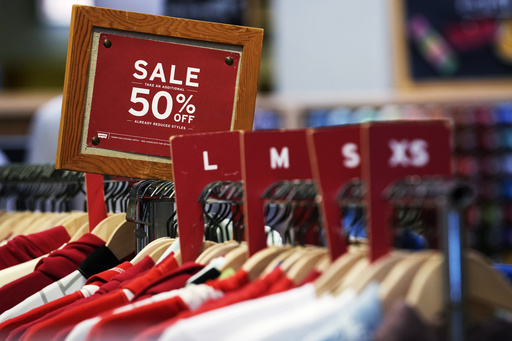WASHINGTON — Inflation in the United States saw an uptick last month, as prices for essentials like groceries, gasoline, and rent increased. This trend presents a challenge for families and businesses already grappling with elevated costs and may reinforce the Federal Reserve’s decision to postpone any further interest rate reductions.
According to a report from the Labor Department, the consumer price index registered a 3% increase in January compared to the previous year—up from 2.9% in December. This figure reflects a rise from a low of 2.4% observed in September, marking a notable persistence of inflation above the Federal Reserve’s target of 2%. This persistent inflation has posed significant political challenges for the current administration, drawing attention to past promises made during election campaigns to address rising prices.
The unexpected rise in inflation could dampen the bullish outlook among businesses, which had initially buoyed after the election of former President Donald Trump, who had made commitments to reduce regulations and taxes. Financial markets reacted negatively, with Dow futures dropping by 400 points, signaling a widespread sell-off is likely as trading opens. Additionally, bond yields rose, indicating that traders predict inflation and interest rates will remain elevated for the foreseeable future.
“We are not seeing any real progress on inflation at this moment,” commented Sarah House, a senior economist at Wells Fargo. “This situation prolongs the Federal Reserve’s current stance.” The month of January frequently sees an uptick in prices as businesses typically implement price hikes at the beginning of the new year. However, House noted that the current inflation levels are unlikely to be a mere temporary increase, attributing it to strong consumer purchasing, particularly among wealthier demographics, which gives businesses little incentive to control their prices.
When excluding volatile food and energy prices, core consumer prices rose by 3.3% in January year-over-year, showing a slight increase from 3.2% in December. Core prices are closely monitored as they provide insight into future inflation trends. On a month-to-month basis, inflation also escalated, with prices climbing by 0.5% from December to January, marking the largest increase since August 2023. Core prices similarly rose by 0.4% during the same timeframe, the highest increment observed since March 2024.
Food prices, particularly for groceries, saw a sharp 0.5% rise in January alone, driven primarily by a dramatic 15.2% increase in egg prices—the most significant monthly rise since June 2015. Egg prices have skyrocketed by 53% compared to one year ago, attributed to an avian flu outbreak forcing producers to cull millions of birds. Some retailers have begun to limit egg purchases, while certain eateries are adding surcharges to dishes that feature eggs.
Moreover, car insurance rates are continuing to rise, increasing by 2% from December to January. Other price hikes include hotel costs, which jumped 1.4%, and gasoline, which went up by 1.8%. Later in the day, Federal Reserve Chair Jerome Powell is set to appear before the House Financial Services Committee, where he is expected to address these inflationary trends and the Fed’s strategy moving forward. The Fed had raised its benchmark interest rate in both 2022 and 2023 to a twenty-year high of 5.3% in an effort to curtail inflation, and although rates were reduced to approximately 4.3% in the final meetings of the last year, this latest rise in prices complicates the Fed’s considerations for future cuts.
Earlier on the same day, Trump expressed his opinion on social media, suggesting that interest rates should be lowered, which he implied could align with forthcoming tariffs. However, the recent rise in consumer prices decreases the likelihood of the Fed cutting rates in the near future.
Economists are particularly concerned about the increase in prices for goods, excluding food and energy, which went up by 0.3% in January, breaking a trend of stability or decline that had persisted following improvements in supply chains after the pandemic. This increase occurs prior to the implementation of significant tariffs that are expected to affect prices for various goods such as vehicles, furniture, and appliances.
Trump’s existing tariffs of 25% on steel and aluminum are anticipated to elevate costs for automobiles, appliances, and other industrial goods. Recently, he has also discussed the potential for “reciprocal tariffs” against nations that maintain high duties on U.S. products. Anthony Saglimbene, chief market strategist at Ameriprise, warned that prolonged uncertainty could negatively impact business confidence, potentially resulting in decreased hiring and investment—a sentiment echoed by many economists.
The recent increase in inflation is a significant factor influencing the Federal Reserve’s decision to halt its interest rate cuts, which had been implemented three times last year. On Tuesday, Powell underscored that the central bank does not need to rush into further reductions. Economists from Goldman Sachs predict a decline in yearly core inflation to approximately 2.3% by the year’s end, although they believe that tariffs could inflate this figure to around 2.8%. Powell has acknowledged that the introduction of higher tariffs could add to inflationary pressures, complicating the Fed’s ability to lower rates, while highlighting the importance of monitoring how many imports would be impacted and for how long.
“The effects can vary greatly depending on the circumstances, and whether they ultimately reach the consumer is also conditional on facts we have yet to ascertain,” Powell stated.




